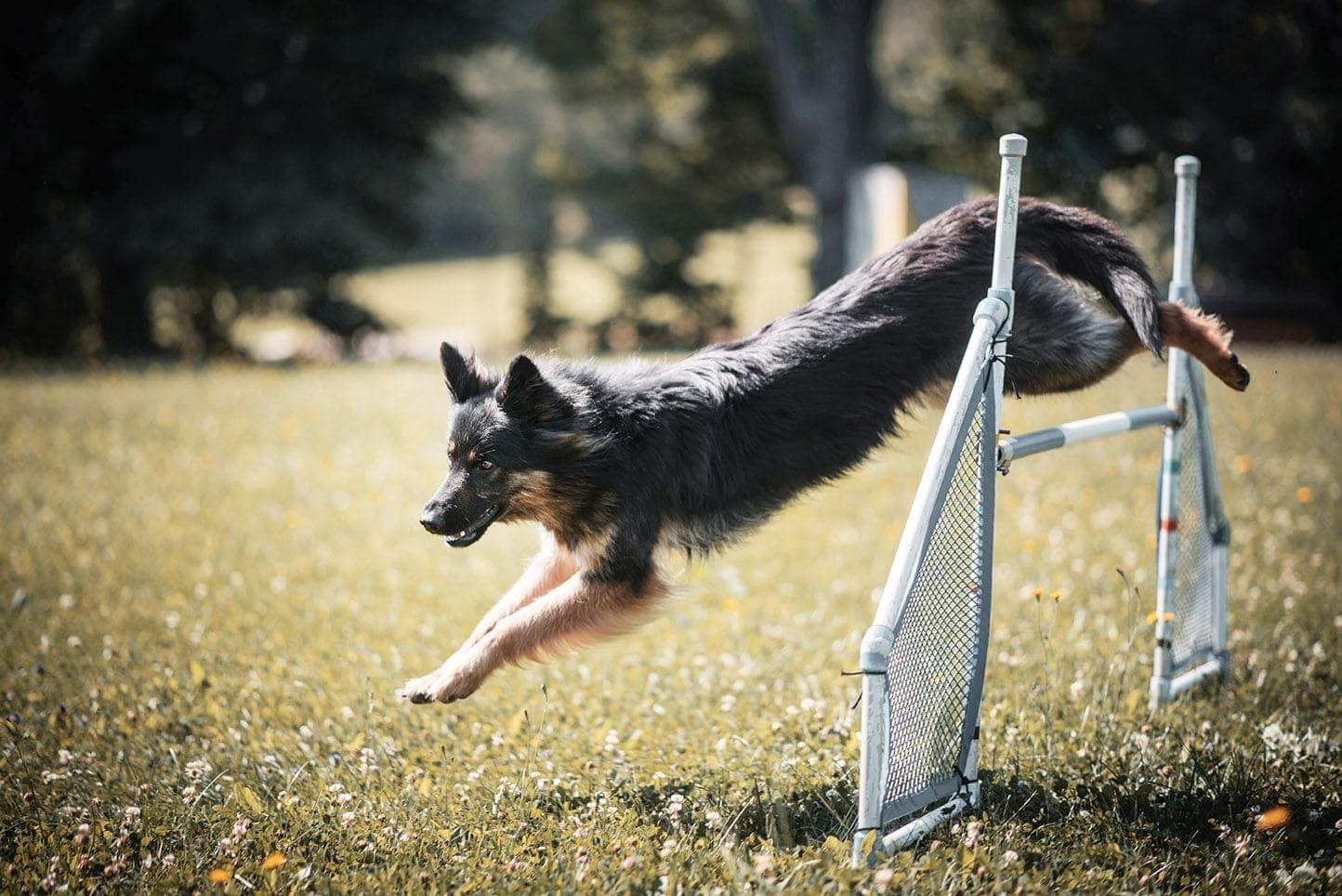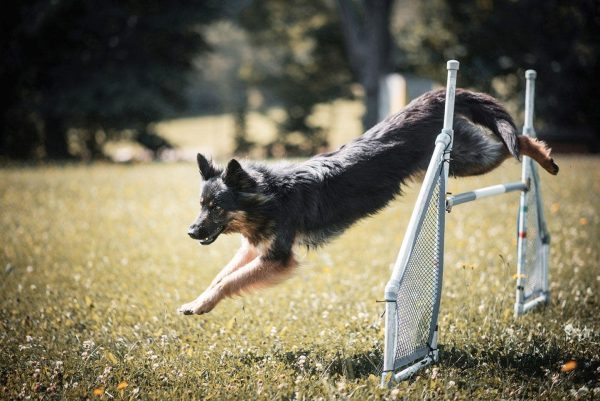The jump command can be useful in everyday life, as well as for dog agility, canine sports, and exhibiting and showing your dog. Having your four-legged friend jump in the back of the car, for example, will be much easier than having to lift them.
If you do intend to take part in shows, it may be a necessity to have them jump up on a pedestal or table, and jumping is a part of obstacle courses and competitive training regimens.
Some dogs naturally take to jumping. In fact, with some breeds, you might be more likely to want to train how to stop jumping. Not all dog breeds can jump, and you shouldn’t encourage dogs like Dachshunds, which have very short back legs, to jump. It can cause injury and permanently damage the back.
The command is of medium difficulty, and with some effort, you should be able to teach almost any dog to jump on command, apart from those that are physically exempt.
It may not happen straight away, and even once your dog grasps the basic command, it will take some reinforcement to maintain it.
What’s Needed?
Some people may be able to train their dogs to jump using nothing but verbal commands and praise. The rest of us require some treats to better facilitate the process.
With any luck, you will need to feed a few treats during each session, because this would suggest that your dog is picking up the process and learning your commands. However, it does mean that you have to be careful about what treats you feed. Anything too high in calories will lead to your dog putting on weight. Anything too rich, especially when combined with jumping up and down, could lead to an upset stomach.
Training treats are small but are considered high-reward treats, so they are appealing to your dog.
If you buy standard dog treats, be prepared to break them down into smaller pieces so that you don’t feed too many calories in a sitting.

Some people like to use the clicker training method. In this training technique, the trainer uses a small clicker to give a clear and audible noise whenever their student performs the desired task. A treat and praise are given at the same time, and the dog eventually associates the click with a reward. Some people swear by this training technique because the click is a unique sound that your dog only hears during training, whereas they hear your voice and your praise all the time. The only additional equipment you require for clicker training is the clicker itself, and the tiny handheld device is cheap, so it may be worth a try.
Finally, depending on your reasons to teach the jump command, you may want something for your dog to jump over. If you are hoping to enroll in dog agility or obstacle courses, introducing your furry friend to a small jump while in your presence and in the comfort of their own yard, will help get them used to the whole process. A dog hurdle fixes into the ground using sharp poles on either end. It’s inexpensive and is the kind of thing that your dog will be expected to jump over during classes.
Training Your Dog to Jump
Several methods can be used to teach the jump command. Which one you use will depend on your willingness to get involved, as well as the reasons for teaching the command in the first place.
The Encouragement Technique
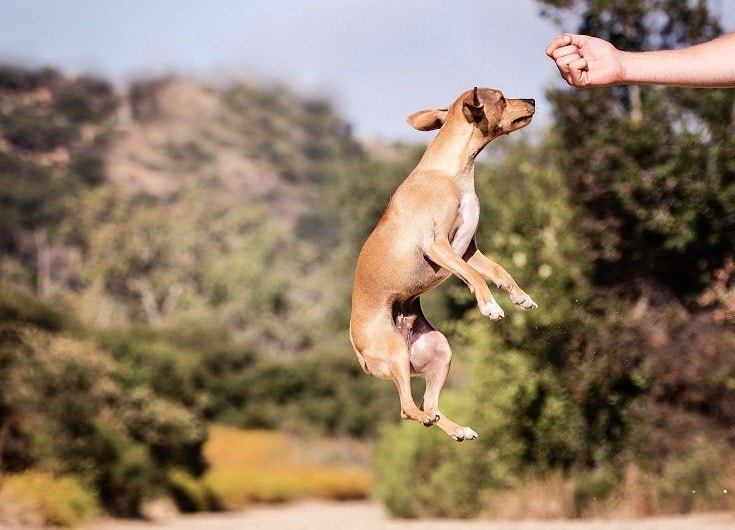
1. Sit
Sit should be one of the first commands that you teach your dog. It will be the starting position for a lot of other work, including teaching your dog to jump. Have him sit in a comfortable position, free from distractions and with no obstacles overhead.
2. Show the Treat
Ensure that you have healthy treats and that they are small but still appealing. Show your dog the treat before holding it above his head. It should be just out of reach, but not so far as to be completely unattainable.
3. The “Jump” Command
If the treat is appealing, your dog will be straining to reach it. Use the “jump” command. It should be friendly, firm, and clear. You may need to try this a few times.
4. Reward
When your dog does jump, which means that his feet leave the floor, give him lots of praise and reward him.
5. Higher and Higher
Practice until your four-legged friend jumps and grabs the treat the first time. Once he can manage this height, move the treat a little higher and repeat the process.
6. Remove the Treat
After you have trained him to jump for the treat, and he has the process down, remove the treat, have him sit, and then give the “jump” command. If he jumps, still give him plenty of praise and, initially, give him a treat. Gradually remove the treat from the process but always give him praise.
Show Them How It’s Done Technique
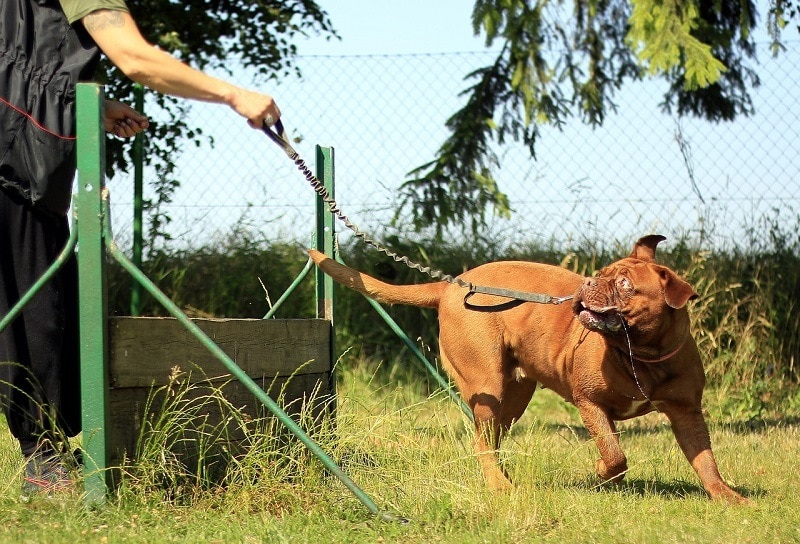
1. Sit
Have your dog start from the same sitting position as above.
2. Show the Treat
Show him the treat and put it above his head, just out of reach.
3. The “Jump” Command
In a firm and friendly voice, give the “jump” command. This time, as he strains to reach the treat, jump with him while trying to keep the treat at the same height. This shows your dog what you want him to do.
4. Reward
When he reaches the treat, let him have it, and give lots of praise at the same time.
5. Higher and Higher
You don’t have to keep making the jump every time. Once your dog knows what you want him to do, increase the height at which you hold the treat, and try using the jump command without physically jumping.
The Table Technique
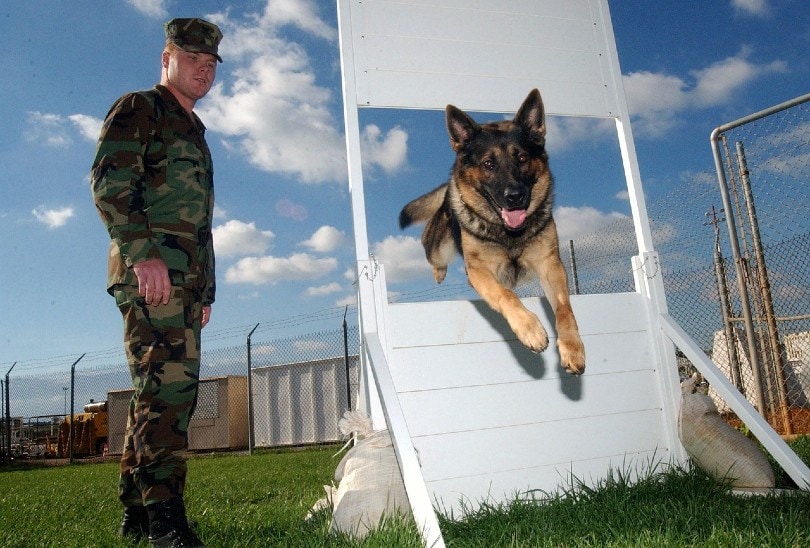
1. Start Low
This technique is useful if you want to show your dog, but it can also be useful when you want to cut nails, physically inspect your dog, or if you want him to jump into the back of the car, for example. Choose a low and sturdy object: something that will take your dog’s weight and won’t fall or slide when he jumps on it. You can increase the height later.
2. Hold the Treat
Hold the treat above the object you want them to jump on.
3. The “Jump” Command
Using your firm and friendly voice, issue the “jump” command.
4. The Reward
When he manages to jump on the table, ensure that he gets the treat as well as a lot of physical praise from you. Your dog didn’t just jump up onto a surface he can’t fully see, but he trusted you to do so.
5. Higher and Higher
As your dog gets comfortable jumping onto a particular surface, increase the height of that surface and have him jump again.
The Hurdle Technique
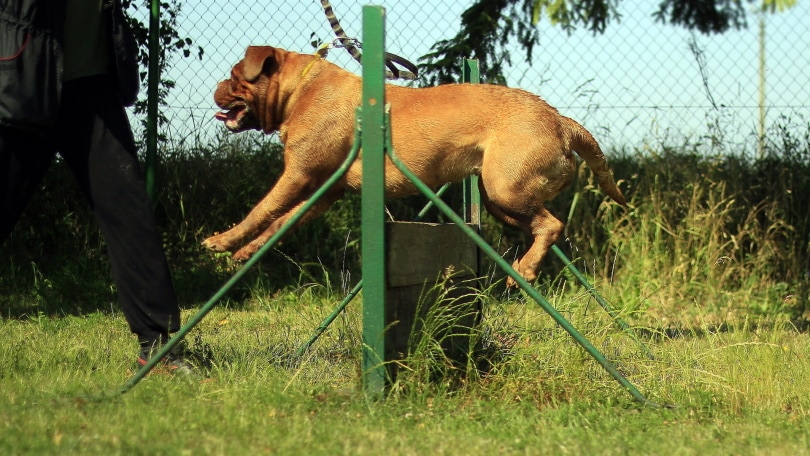
1. Start Low
Hurdles and obstacles are used in agility and obstacle courses. Teaching your dog to jump over an obstacle can also prove useful in everyday life. Whether you make your own hurdles using cinder blocks and planks, or you have bought an adjustable hurdle, ensure it is low to the ground when you start. You may need to start with the hurdle so low that it is barely off the ground. An obstacle that’s too high will put your dog off, or encourage him to find a different way to beat the obstacle.
2. Place the Treat
Place the treat on the other side of the hurdle as your dog.
3. Make the Jump
Walk or jog your dog towards the jump so that he is naturally encouraged to jump over the hurdle and towards the treat.
4. Praise
When the dog makes the jump, he should be allowed the treat, and you should give him lots of praise and adulation.
5. Practice
Keep practicing at the same height so your dog gets the idea and starts to make the jump without having to think about it.
6. Raise the Bar
Once you’re both comfortable at this height, move the bar up slightly and repeat the process. Keep treating and rewarding and moving the bar up when your dog masters a height.
Consistency Is Key
Whatever training method and jumping technique you encourage, the key is reward, repetition, and consistency. Don’t give up after a single session, and don’t assume that your dog has mastered the skill simply because he did it for 5 minutes one Sunday afternoon.
Although you should continue to praise and reward your dog, you don’t have to keep giving treats. Gradually phase the treat out. Initially, rather than giving a treat after every successful jump, give one every other successful jump and then every third successful jump. Continue to give praise, and your dog will continue to perform the jump for you.
Can All Dogs Jump?
Not all dogs can jump. Breeds like the Dachshund, with their short legs and fragile back, should be discouraged from jumping at all, and if you show them, you will be allowed to pick them up onto the table or show them from a ground position. Similarly, some giant breeds are discouraged from jumping onto platforms, often because the act of getting down and the position of their center of gravity means that they are at risk of falling forward and seriously injuring themselves.
If you are in any doubt, check with a vet before embarking on any agility or canine sports classes with your dog. They will be able to tell you whether it is safe.
Why Is My Dog Scared to Jump?
There are several reasons your dog might be scared of jumping. He may have been reprimanded or scolded for jumping on furniture in the past, or he may have fallen badly and hurt himself when attempting to jump over an object. If your dog cannot see what is on top of a surface or the other side of an obstacle, it means putting a lot of faith and trust in you and the situation. Be patient, show your dog that everything is safe, and use treats, encouragement, and praise to get through the fear.
Final Thoughts
Training requires patience. It goes better with praise, and it can be reinforced with treats. How easy it is to teach a dog to jump depends on the breed of dog, the individual dog’s character, and your persistence. Using the techniques above, you should be able to teach your dog to jump up to, onto, and over any object necessary.
Featured Image: Ellis Berankova, Shutterstock
Contents
- What’s Needed?
- Training Your Dog to Jump
- The Encouragement Technique
- 1. Sit
- 2. Show the Treat
- 3. The “Jump” Command
- 4. Reward
- 5. Higher and Higher
- 6. Remove the Treat
- Show Them How It’s Done Technique
- 1. Sit
- 2. Show the Treat
- 3. The “Jump” Command
- 4. Reward
- 5. Higher and Higher
- The Table Technique
- 1. Start Low
- 2. Hold the Treat
- 3. The “Jump” Command
- 4. The Reward
- 5. Higher and Higher
- The Hurdle Technique
- 1. Start Low
- 2. Place the Treat
- 3. Make the Jump
- 4. Praise
- 5. Practice
- 6. Raise the Bar
- Consistency Is Key
- Can All Dogs Jump?
- Why Is My Dog Scared to Jump?
- Final Thoughts

